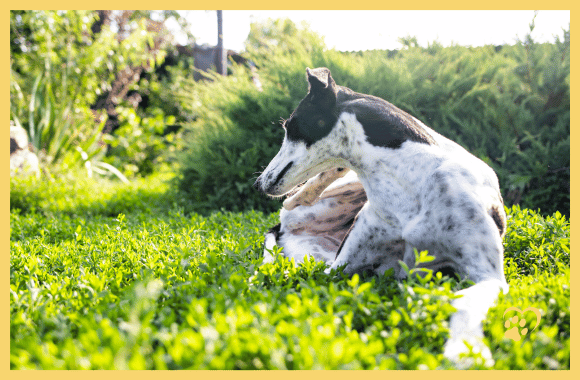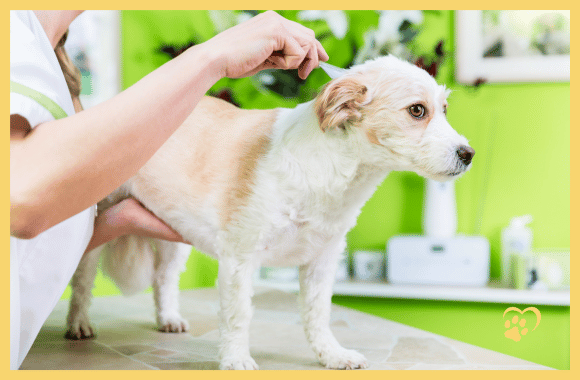If you discover fleas on your dog, this can quickly cause concern. But there is no need to panic. With our step-by-step guide to parasite control, we offer you clear and simple help. We'll show you how to effectively rid your dog of fleas. And it's easier than you think.
What exactly are fleas and why are they a problem?
What exactly are fleas?
Fleas are small, wingless insects that are among the most effective jumpers in the animal world. They have special hind legs that allow them to jump from one host to another or into the environment at lightning speed. This makes them an extremely difficult enemy to catch once they have nested in the house or on the pet.
Why are fleas a problem?
Fleas are not only unpleasant, they can also make you ill. They irritate your dog's skin and can cause allergies, inflammation and even hair loss. Some dogs develop a flea saliva allergy, an allergic reaction to flea bites that causes even more suffering. Fleas can also transmit tapeworms, which pose a further health risk.
So fleas are more than just a nuisance. They are a Health risk for your dog and require quick and effective measures.
Recognize fleas
When it comes to fleas Early detection is the key to avoiding major problems. Your dog may not be able to tell you directly that it is infested with fleas, but its behavior and appearance will usually give you clear clues.
Flea bites and itching
Constant scratching or biting of the skin is often the first sign that your dog may be infested with fleas. Fleas have a preference for certain areas of skin such as the neck, back and base of the tail. Look out for small red bites or dots - typical flea bites.
Flea droppings
Take a magnifying glass and look for small black crumbs in your dog's coat. These are flea droppings, which contain dried blood and indicate an active infestation. A good trick is to place these crumbs on a piece of damp white paper. If it turns red, this is a clear indication of flea droppings.
Restlessness and conspicuous behavior
Fleas can be very annoying for dogs. If your dog seems restless, shakes frequently or is unusually restless, this may be a sign of discomfort caused by fleas.
Flea comb
A flea comb is your best friend when it comes to flea control. Use it to carefully comb through your dog's coat and look for fleas or flea droppings left in the comb. This is an effective control method, especially after a walk in the grass.
Through careful observation and regular checks, you can recognize fleas at an early stage and act quickly.

How to protect your dog effectively
With the right measures, you can keep the little pests away. Let's take a look at how you can keep your dog and your home flea-free.
General preventive measures
Cleanliness is the be-all and end-all. Regular Vacuuming and washing dog beds and blankets at high temperatures make it difficult for fleas to nest. Don't forget to keep an eye on your garden too. Keep the grass short and the bushes in check, as parasites like to lurk there too.
Natural prevention
Pure nature can help. Some dog owners swear by the preventative effect of lemon water, which they spray gently into the coat. Equally popular are essential oils such as lavender or eucalyptus - but be careful: always use only diluted and carefully, as not every animal tolerates them well.
Recommended products for flea control
There is a wide range of products available to keep fleas away. Whether spot-on preparations, flea collars or oral medication - it is important that you find the right one for your dog and its specific needs. Talk to your vet about the best options. Only a professional can recommend the right remedy for your four-legged friend that is effective and safe.
Spot-on preparations
- ApplicationThese liquids are applied once a month to the skin on the back of the dog's neck where the animal cannot lick them off.
- Active ingredientsThey often contain insecticides and growth inhibitors to combat fleas and their larvae and eggs.
- ExamplesFrontline Plus, which additionally protects against ticks, or Advantage II, which specifically combats fleas and can alleviate allergic reactions.
- Duration of effectivenessProtection against new infestation for up to 30 days.
- Special notesThe dog's reaction should be observed during the first application to rule out allergic reactions.
Oral flea medication
- ApplicationThese preparations are administered in the form of tablets or chewable capsules and can often be easily mixed into the food.
- EffectThey act systemically by circulating in the blood and killing fleas as they suck blood.
- ProductsComfortis, which is effective for one month, or Capstar, which kills fleas within 30 minutes but has no long-term effect.
- AdvantagesNo residue on the skin, ideal for families with children.
Flea collars
- EffectThey release insecticides that spread on the skin and form a protective film.
- Popular brandsSeresto offers long-lasting protection and is also waterproof, which is an advantage when bathing or swimming.
- Duration of protectionCan last up to eight months, making it a cost-effective option.
Flea shampoos and sprays
- ApplicationDirect shampooing or spraying of the coat, often in combination with a bath.
- Active ingredientsMostly insecticides that work immediately against fleas.
- NoteThe effect is usually short-lived and requires regular use.
Environmental sprays
- Area of applicationHousehold sprays that are applied to the animal's environment to kill fleas at all life stages.
- ProductsVirbac Knockout E.S. Area Treatment, which also has a preventive effect against new infestations, or natural alternatives such as Vet's Best with essential oils.
- Use with caution so as not to endanger other pets or children.
Powders and sprays for direct application
- ApplicationApply to the dog's coat and massage in.
- EffectThey often have an immediate effect and can be helpful in acute infestations.
- Regularity: Several applications are necessary for a long-term effect.
Flea combs
- Application: Regular combing of the coat to remove fleas. and their eggs to remove.
- AdvantagesChemical-free and safe, especially for puppies and pregnant bitches.
- TipsRegular application increases the effectiveness and helps to keep the flea population under control.
Choose products that are appropriate for the size and health of your dog. Ideally, combine several methods for effective flea control. Always consult with a veterinarian before introducing a new flea prevention or control product.
What to do after flea treatment?
Once you have started flea control, it is important not to let up. The time after the treatment is just as important as the control itself.
Observe your dog's reaction
It is important to observe your dog closely after each flea treatment. Look out for signs of an allergic reaction or intolerance. These include excessive scratching, reddening of the skin or unusual behavior. If you notice such symptoms, you should act quickly and consult a vet if necessary.
Cleanliness has priority
Fleas not only like to hide in fur niches, but also in home textiles. Therefore, wash all your dog's beds, pillows and blankets regularly. A clean home is the best defense against re-infestation. Also remember to vacuum regularly, especially in corners and under furniture, to remove any flea hiding places.
When to go to the vet?
If the fleas return despite your best efforts or your dog shows symptoms that worry you, do not hesitate to see your vet. In particular, you should see a specialist if you have persistent skin problems, digestive problems or if your dog seems lethargic. The vet can not only help you with flea control, but also ensure that no other health problems are overlooked.

Long-term strategies for your dog
Once the flea infestation has been controlled, you want to make sure that the pests don't come back. A good long-term strategy can protect you and your dog from re-infestation. Here you can find out how to minimize the risk and what you should look out for in the long term.
Making prevention a habit
Make prevention an integral part of your dog's grooming routine. Regular use of flea preventatives such as spot-on products or flea collars can help keep fleas away. It is important that you do not miss the intervals. Set reminders in your calendar or on your cell phone so that you carry out the treatments on time.
Keeping an eye on nutrition and the environment
Believe it or not, A good diet can also make your dog less susceptible to parasites. A strong immune system, supported by a balanced diet, makes it easier for your dog to defend itself against fleas and other parasites. The environment is just as important: keep your garden clean and free of garbage, as fleas can also lurk there.
Avoid common pitfalls
It's easy to get careless when everything seems to be in order. But remember: fleas can come back at any time. A common mistake is to neglect prevention in winter. Fleas can survive in colder temperatures, especially in a warm house. So be vigilant all year round and don't let your guard down.
If you follow these tips and regularly check for fleas, you can protect your dog and your home in the long term. A life without fleas for your dog means less stress and more joy for both of you!
Read also:
- Help, my dog does what he wants: a guide to dog training

- Do I have to keep my dog busy eight hours a day?

- How do I develop my dog's intelligence?

Your guide to a flea-free home for your four-legged friend
Now you're armed! With these tips and tricks, you have everything you need to declare war on fleas and protect your dog in the long term. Remember that prevention is always better than cure and that your dog's health comes first.
Make regular flea control a fixed part of your routine and you will find that it is not that difficult to keep the little pests away.
Your dog will thank you with lots of tail wagging and carefree days outdoors.
